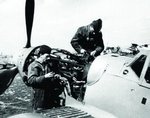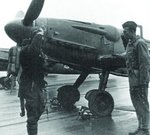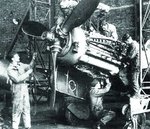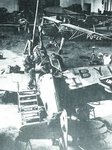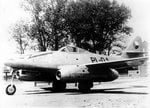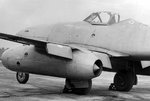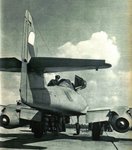- Thread starter
- #41
Navigation
Install the app
How to install the app on iOS
Follow along with the video below to see how to install our site as a web app on your home screen.
Note: This feature may not be available in some browsers.
More options
You are using an out of date browser. It may not display this or other websites correctly.
You should upgrade or use an alternative browser.
You should upgrade or use an alternative browser.
Czechoslovakia Air Force
- Thread starter gekho
- Start date
Ad: This forum contains affiliate links to products on Amazon and eBay. More information in Terms and rules
More options
Who Replied?- Thread starter
- #42
The Avia S.199 was a Czech version of the Messerschmitt Bf 109G-14 manufactured at previously German-controlled factories from the Messerschmitt blueprints. The standard airframe was combined with the only available engine, the Jumo 211F, and the result differed from the original German design by having a larger engine cowling and a tri-blade propeller. The S.199 had very difficult handling characteristics, especially during takeoff and landing, and very unforgiving controls, reasons for which it was dubbed "Mezek" (mule) by its Czech pilots. About 550 examples had been built by the time production ended in 1949.
Attachments
Last edited:
imalko
Chief Master Sergeant
Nice! Always liked something about the appearance of S-199. Too bad it had such poor handling characteristics due to the inadequate engine. Actually Daimler-Benz DB605 engines were available in substantial number in Czechoslovakia immediately after the war, but situation changed after large supply of these engines was destroyed in a fire and explosion at a warehouse in Krásné Březno thus forcing the usage of alternative engine for Bf 109 airframe. Two seat trainer version of S-199 was also build in some numbers under designation Avia CS.199.
Here are few more pictures...
Here are few more pictures...
Attachments
- Thread starter
- #44
The Lisunov Li-2, originally designated PS-84 (NATO reporting name: Cab), was a license-built version of the Douglas DC-3. It was produced by the GAZ-84 works near Moscow, and subsequently at GAZ-34 in Tashkent. The project was directed by aeronautical engineer Boris Pavlovich Lisunov.The Soviet Union received its first DC-2 in 1935. Although a total of 18 DC-3s had been ordered on 11 April 1936, the Soviets purchased 21 DC-3s for operation by Aeroflot before World War II. The arrangement accompanied a free production license on 15 July 1936. Lisunov spent two years at the Douglas Aircraft Company, between 1938 and 1940 and modified the C-47 into a Soviet version, which was given the designation PS-84 - Passazhirskiy Samolyot 84, passenger airplane 84.
Despite the original intention to incorporate as few changes as necessary to the basic design, the GAZ-84 works documented over 1,200 engineering changes from the Douglas engineering drawings, and it was no small task for Vladimir Myasishchev to change all dimensions from U.S. customary units to metric units. Some of the changes were substantial, such as the use of the Russian Shvetsov ASh-62IR engines. The Russian standard design practice also usually mandated fully shuttered engines in order to cope with the extreme temperatures. A slightly shorter span was incorporated but many of the other alterations were less evident. The passenger door was moved to the right side of the fuselage, with a top-opening cargo door on the left side in place of the original passenger door. The structural reinforcement included slightly heavier skins necessitated since the metric skin gauges were not exact duplicates of the American alloy sheet metal. Standard Russian metric hardware was different and the various steel substructures such as engine mounts and landing gear, wheels, and tires were also quite different from the original design. Later modifications allowed the provision of ski landing gear in order to operate in remote and Arctic regions. The first PS-84s began to emerge from the GAZ-84 production line by 1939. Some military versions of the Li-2 also had bomb racks and a dorsal turret, unlike the military C-47 development of the DC-3.
The PS-84 had flown with Aeroflot primarily as a passenger transport before World War II. When Germany attacked the Soviet Union in 1941 many of the PS-84s were taken into military use and redesignated the Lisunov Li-2 in 1942. The military models were equipped with a 7.62 mm (.30 in) ShKAS machine gun, and later with a 12.7 mm (.50 in) UBK heavy machine gun. The aircraft were used for transport, partisan supply, bombing, and as ambulance aircraft. A version designated Li-2VV (Vojenny Variant = military variant) had a redesigned nose for extra defensive armament and could carry up to four 250 kg (551 lb) bombs under the wings. Smaller bombs could be carried inside the fuselage and thrown out the freight hatch by the crew. A total of 4,937 aircraft were produced of all Li-2 versions between 1940 and 1954 and it saw extensive use in Eastern Europe until the 1960s. The last survivors in use were noted in China and Vietnam during the 1980s. There were many versions, including airliner, cargo, military transport, reconnaissance, aerial photography, parachute drop, bomber, and high altitude variants. The Li-2 also saw extensive service in the Chinese Air Force in the 1940s and 1950s.
Despite the original intention to incorporate as few changes as necessary to the basic design, the GAZ-84 works documented over 1,200 engineering changes from the Douglas engineering drawings, and it was no small task for Vladimir Myasishchev to change all dimensions from U.S. customary units to metric units. Some of the changes were substantial, such as the use of the Russian Shvetsov ASh-62IR engines. The Russian standard design practice also usually mandated fully shuttered engines in order to cope with the extreme temperatures. A slightly shorter span was incorporated but many of the other alterations were less evident. The passenger door was moved to the right side of the fuselage, with a top-opening cargo door on the left side in place of the original passenger door. The structural reinforcement included slightly heavier skins necessitated since the metric skin gauges were not exact duplicates of the American alloy sheet metal. Standard Russian metric hardware was different and the various steel substructures such as engine mounts and landing gear, wheels, and tires were also quite different from the original design. Later modifications allowed the provision of ski landing gear in order to operate in remote and Arctic regions. The first PS-84s began to emerge from the GAZ-84 production line by 1939. Some military versions of the Li-2 also had bomb racks and a dorsal turret, unlike the military C-47 development of the DC-3.
The PS-84 had flown with Aeroflot primarily as a passenger transport before World War II. When Germany attacked the Soviet Union in 1941 many of the PS-84s were taken into military use and redesignated the Lisunov Li-2 in 1942. The military models were equipped with a 7.62 mm (.30 in) ShKAS machine gun, and later with a 12.7 mm (.50 in) UBK heavy machine gun. The aircraft were used for transport, partisan supply, bombing, and as ambulance aircraft. A version designated Li-2VV (Vojenny Variant = military variant) had a redesigned nose for extra defensive armament and could carry up to four 250 kg (551 lb) bombs under the wings. Smaller bombs could be carried inside the fuselage and thrown out the freight hatch by the crew. A total of 4,937 aircraft were produced of all Li-2 versions between 1940 and 1954 and it saw extensive use in Eastern Europe until the 1960s. The last survivors in use were noted in China and Vietnam during the 1980s. There were many versions, including airliner, cargo, military transport, reconnaissance, aerial photography, parachute drop, bomber, and high altitude variants. The Li-2 also saw extensive service in the Chinese Air Force in the 1940s and 1950s.
Attachments
seesul
Senior Master Sergeant
I am interesting in all Air Forces, not only yours, my friend. And I also think Czech aircrafts are very interesting.
O.K., roger
seesul
Senior Master Sergeant
Czechoslovak pilots encountered Lavochkin La-5FN for the first time in April 1944, when a group of some 20 airmen (previously flying in RAF on Spitfires and Hurricanes) started retraining on Soviet aircraft at Ivanovo airfield some 350km north of Moscow. These airmen made the core of the 1st Czechoslovak Fighter Aviation Regiment (1. ČSSLP) formed in June 1944. Two pilots of Slovak nationality (A.Matušek and L.Dobrovodský), formerly members of Slovak Air Arms, who defected to the Soviets a year before also joined the new unit.
Upon the outbreak of Slovak National Uprising in August 1944 the Regiment was deployed in support of the insurgents operating from airfields Zolná and Try Duby in insurgent territory. During the 40 days of fighting pilots of 1. ČSSLP shot down 9 confirmed and 3 unconfirmed enemy aircraft and damaged further 7 enemy aircraft, six German aircraft were destroyed on the ground. Significant success was achieved in ground attack missions against advancing German forces. During this time the regiment suffered three fatal casualties. After the suppression of the uprising 1. ČSSLP was withdrawn from Slovakia.
During the fallowing winter new Czechoslovak fighter and ground attack aviation units were formed with Soviet help, including 2nd Czechoslovak Fighter Aviation Regiment also equipped with La-5FN fighters. All these units were gathered into 1st Czechoslovak Mixed Aviation Division under Soviet 8th Air Army and took part in final Soviet push through Czechoslovakia, distinguishing themselves especially in attacks on heavily defended Moravian Gate near Ostrava.
During their wartime service all Czechoslovak La-5FN fighters wore Soviet national insignia and standard Soviet late war camouflage colors and tactical markings (large white numbers on aft fuselage). Only after the war red stars were over painted with Czechoslovak roundels.
Note: Source of some pictures in the attachment "Slovenske letectvo 1939-1945" Volume 3, others found on the internet (exact source unknown).
HI Igor,
one of those 20 Czechoslovakian 'RAF' pilots who went to USSR, were trained there and then landed with their La-5FNs behind enemy lines in Slovakia and fought agains Germans during Slovak national urprising was Joe Stehlik, an ace with 10+ kills achieved in France, England and Slovakia. He often flew 'white 12' (La-5FN) during the Slovak national urprising. It might be him during taking off on the last pic you´ve posted...
I was lucky enough that he moved at the end of 60´s to my born town and I had a chance to speak to him. I still regret he passed away so soon in 1991...
http://www.ww2aircraft.net/forum/stories/s-ldr-josef-stehl-k-four-airforces-1603.html
imalko
Chief Master Sergeant
That's very interesting Roman. He must have some interesting stories to tell you.
Too bad he passed away.
Too bad he passed away.

Nice stuff!
- Thread starter
- #50
Designed by Walter Blume as the result of a 1936 Reich Air Ministry tender, the prototype, powered by a 179 kW (240 hp) Argus As 10c engine, first flew in 1938. In 1939, an initial batch of Ar 96A aircraft was produced. This was followed by the major production series, the more powerful Ar 96B, fitted with the Argus As 410 engine. The Ar 96 was used for advanced, night and instrument flying training. Shadow production was undertaken by Letov and the Avia factory in occupied Czechoslovakia, where manufacturing continued for some years after the war, being designated C-2. A wooden version known as the Ar 396 was built in France and was designated SIPA SS.11. Further developments were the SIPA 111 (armed version), and SIPA S-12, a metal version. 58 Machines were produced until 1958. The S.11 was operated with some success in Algeria carrying machine guns, rockets and light bombs. Czechoslovakian Air Force operated Avia C-2 variant postwar.
Source: Arado Ar 96 - Wikipedia, the free encyclopedia
Source: Arado Ar 96 - Wikipedia, the free encyclopedia
Attachments
Nice stuff!
- Thread starter
- #54
During the war the Germans set up a number of assembly plants in Czechoslovakia for the of the production Messerschmitt Me 262. After the war the manufacturing infrastructure remained intact, so production could start up again for the new owners. This decision was taken remarkable quickly after the Soviet "Liberation" on the 27/5/1945. The first Avia S 92.1 was assembled at Letnany Research Institute in 1945 (PL-01), with the air frame coming from Avia and the engines from the repair works in Malesice (the Junkers Jumo 004 now called the M-04). The S 92's first flight was on the 27/09/46, with Avia's chief pilot Antonin Kraus in control. That same year on December 10th the CS 92 took to the air for the first time.
Delivery of the first S 92 to the Czech air force was on 42/6/1948. With twelve being made in all, nine S 92 and three CS 92 equipping the 5th Fighter Flight, until they were grounded for use as instructional airframes in 1951. By the time Yugoslavia showed interest in buying the S 92, Avia was looking at closing down the production line to make way for new up to date aircraft and when Avia were given a licensed to make the Mig 15 (they were all ready making the Yak 23 as the S 101) the S 92 facilities were broken up.
Source: Avia S-92
Delivery of the first S 92 to the Czech air force was on 42/6/1948. With twelve being made in all, nine S 92 and three CS 92 equipping the 5th Fighter Flight, until they were grounded for use as instructional airframes in 1951. By the time Yugoslavia showed interest in buying the S 92, Avia was looking at closing down the production line to make way for new up to date aircraft and when Avia were given a licensed to make the Mig 15 (they were all ready making the Yak 23 as the S 101) the S 92 facilities were broken up.
Source: Avia S-92
Attachments
Users who are viewing this thread
Total: 1 (members: 0, guests: 1)
Similar threads
- Replies
- 4
- Views
- 511




